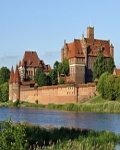Malbork Castle
Archaeology »
Archaeological Monuments » Malbork Castle
Malbork Castle -
Malbork Castle is located in Europe.
Malbork Castle monument was established on 1406.
Primary threats to Malbork Castle :
Historical facts of Malbork Castle :
- Malbork Castle, also known as the Castle of the Teutonic Order in Malbork, is a magnificent medieval fortress located in the town of Malbork, Poland. It is considered one of the most impressive and well-preserved Gothic castles in Europe. Established in 1406, the castle served as the residence and headquarters of the Teutonic Knights, a medieval Catholic military order.
- The history of Malbork Castle dates back to the 13th century when the Teutonic Knights, originally from Germany, arrived in the region to carry out their crusades against pagans in Prussia. They constructed a wooden fortress on the site, which was later replaced with a stone castle due to its strategic importance and the increasing influence of the Teutonic Order.
- The castle complex consists of three main sections: the High Castle, the Middle Castle, and the Low Castle. The High Castle, the oldest part of the complex, was primarily used for military purposes. It features fortified walls, towers, and a moat. The Middle Castle served as the administrative center, housing the grand master's residence, chapels, and administrative offices. The Low Castle functioned as the economic hub, with workshops, granaries, and stables.
- Throughout its history, Malbork Castle witnessed numerous significant events. In 1410, during the famous Battle of Grunwald, the castle was besieged by the Polish-Lithuanian forces led by King W?adys?aw II Jagie??o, dealing a severe blow to the Teutonic Order's dominance in the region. However, the castle withstood the attack and remained a symbol of the order's power.
- Over the centuries, the castle underwent several expansions and renovations. Grand Masters of the Teutonic Order continuously expanded the fortress, adding defensive walls, towers, and majestic halls. The castle's architectural design combines Gothic elements with the military features of a fortress, showcasing the order's wealth and power.
- In the 15th century, the Teutonic Knights faced financial difficulties, leading to the secularization of the order and the conversion of the castle into a residence for Polish kings. The castle became part of the Polish Crown and underwent further modifications to suit the needs of its new occupants.
- During World War II, Malbork Castle suffered severe damage due to heavy bombings. However, extensive restoration work was carried out in the post-war years, restoring the castle to its former glory. In 1997, the castle was designated as a UNESCO World Heritage Site, recognizing its historical significance and architectural splendor.
- Today, Malbork Castle stands as a major tourist attraction, drawing visitors from all over the world. It offers a glimpse into the medieval history of the Teutonic Order and the captivating architecture of the Gothic period. The castle houses a museum that showcases an impressive collection of medieval artifacts, including weapons, armor, and religious objects.
- The monumental presence of Malbork Castle serves as a reminder of the grandeur and power of the Teutonic Knights. Its historical significance, architectural beauty, and rich cultural heritage make it a remarkable symbol of medieval Europe and a must-visit destination for history enthusiasts and tourists alike.

